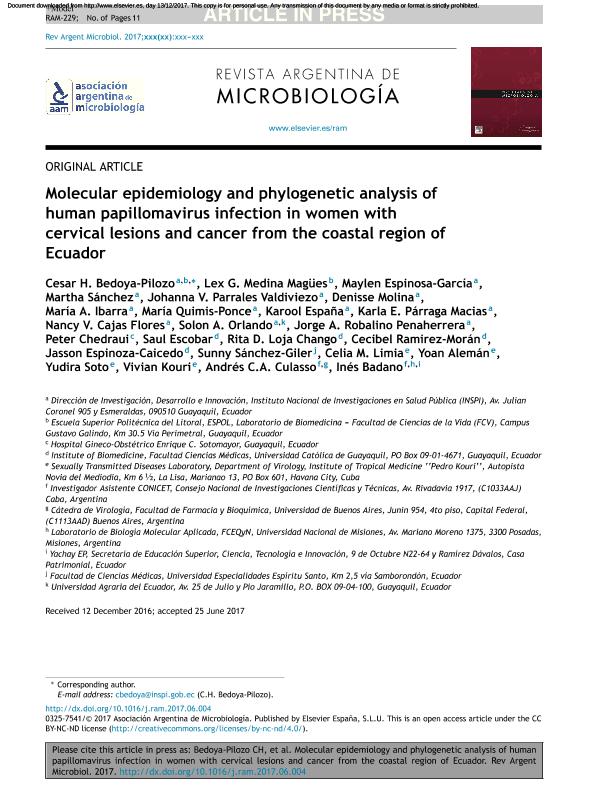Artículo
Molecular epidemiology and phylogenetic analysis of human papillomavirus infection in women with cervical lesions and cancer from the coastal region of Ecuador
Título:
Epidemiología molecular y análisis filogenético de la infección por el virus del papiloma humano en mujeres con lesiones cervicales y cáncer en la región litoral del Ecuador
Bedoya Pilozo, Cesar H.; Medina Magües, Lex G.; Espinosa García, Maylen; Sánchez, Martha; Parrales Valdiviezo, Johanna V.; Molina, Denisse; Ibarra, María A.; Quimis Ponce, María; España, Karool; Párraga Macias, Karla E.; Cajas Flores, Nancy V.; Solon, Orlando A.; Robalino Penaherrera, Jorge A.; Chedraui, Peter; Escobar, Saul; Loja Chango, Rita D.; Ramirez Morán, Cecibel; Espinoza Caicedo, Jasson; Sánchez Giler, Sunny; Limia, Celia M.; Alemán, Yoan; Soto, Yudira; Kouri, Vivian; Culasso, Andrés Carlos Alberto ; Badano, Ines
; Badano, Ines
 ; Badano, Ines
; Badano, Ines
Fecha de publicación:
12/2017
Editorial:
Asociación Argentina de Microbiología
Revista:
Revista Argentina de Microbiología
ISSN:
0325-7541
e-ISSN:
1851-7617
Idioma:
Inglés
Tipo de recurso:
Artículo publicado
Clasificación temática:
Resumen
The aim of the present study was to gather information regarding the molecular epidemiology of Human papillomavirus (HPV) and related risk factors in a group of women with low- and high-grade cervical lesions and cancer from the coastal region of Ecuador. In addition, we studied the evolution of HPV variants from the most prevalent types and provided a temporal framework for their emergence, which may help to trace the source of dissemination within the region. We analyzed 166 samples, including 57 CIN1, 95 CIN2/3 and 14 cancer cases. HPV detection and typing was done by PCR-sequencing (MY09/MY11). HPV variants and estimation of the time to most recent common ancestor (tMRCA) was assessed through phylogeny and coalescence analysis. HPV DNA was found in 54.4% of CIN1, 74.7% of CIN2/3 and 78.6% of cancer samples. HPV16 (38.9%) and HPV58 (19.5%) were the most prevalent types. Risk factors for the development of cervical lesions/cancer were the following: three or more pregnancies (OR = 4.3), HPV infection (OR = 3.7 for high-risk types; OR = 3.5 for HPV16), among others. With regard to HPV evolution, HPV16 isolates belonged to lineages A (69%) and D (31%) whereas HPV58 isolates belonged only to lineage A. The period of emergence of HPV16 was in association with human populations (tMRCA = 91. 052 years for HPV16A and 27. 000 years for HPV16D), whereas HPV58A preceded Homo sapiens evolution (322. 257 years). This study provides novel data on HPV epidemiology and evolution in Ecuador, which will be fundamental in the vaccine era.
Palabras clave:
Cancer
,
Ecuador
,
Human Papilloma Virus
,
Pcr-Sequencing
,
Phylogenetic Analysis
Archivos asociados
Licencia
Identificadores
Colecciones
Articulos(CCT - NORDESTE)
Articulos de CTRO.CIENTIFICO TECNOL.CONICET - NORDESTE
Articulos de CTRO.CIENTIFICO TECNOL.CONICET - NORDESTE
Citación
Bedoya Pilozo, Cesar H.; Medina Magües, Lex G.; Espinosa García, Maylen; Sánchez, Martha; Parrales Valdiviezo, Johanna V.; et al.; Molecular epidemiology and phylogenetic analysis of human papillomavirus infection in women with cervical lesions and cancer from the coastal region of Ecuador; Asociación Argentina de Microbiología; Revista Argentina de Microbiología; 12-2017; 1-11
Compartir
Altmétricas



